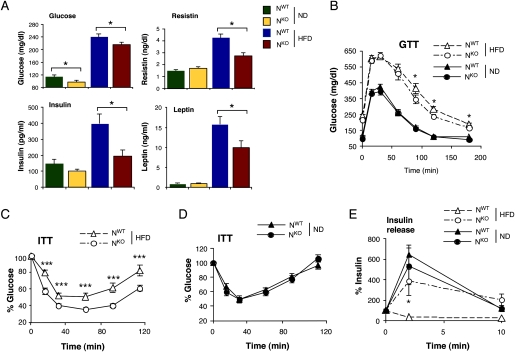Figure 3.
JNK1 deficiency in the nervous system partially protects mice against the metabolic effects of feeding a HFD. (A) Blood glucose concentration in chow-fed (ND) and HFD-fed NWT and NKO mice fasted overnight. The blood concentration of insulin, resistin, and leptin in mice fasted overnight is also presented. The data represent the mean ± SD (n = 10). Statistically significant differences between NKO and NWT are indicated ([*] P < 0.05). (B) Glucose tolerance tests (GTT) on chow-fed (ND) and HFD-fed NWT and NKO mice were performed by measurement of blood glucose concentration in animals following intraperitoneal injection of glucose (1 g/kg). The data presented represent the mean ± SD (n = 10∼15). Statistically significant differences between NKO and NWT are indicated ([*] P < 0.05). (C,D) Insulin tolerance tests (ITT) on NWT and NKO mice fed either a chow diet (ND) or a HFD were performed by intraperitoneal injection of insulin (1.5 U/kg body mass). The concentration of blood glucose was measured (mean ± SD; n = 10). Statistically significant differences between NKO and NWT are indicated ([***] P < 0.001). (E) Glucose-induced insulin release. The effect of administration of glucose (2 g/kg body mass) by intraperitoneal injection on blood insulin concentration was examined (mean ± SD; n = 13∼15). Statistically significant differences between NWT and NKO mice are indicated ([*] P < 0.05).

